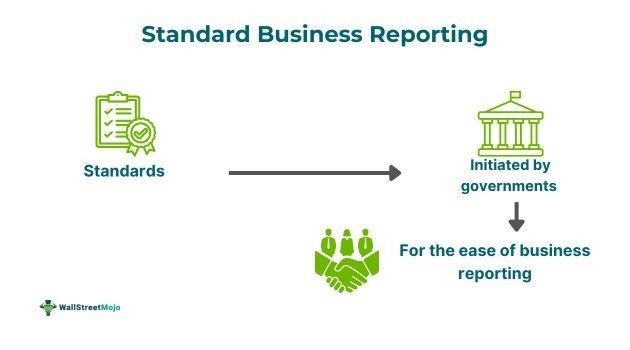Table of Contents
What Is Standard Business Reporting (SBR)?
Standard business reporting (SBR) is a group of policy frameworks adopted by various governments to promote business data reporting. The idea is to introduce standardization in filing reports about business performance, customs and tax administration, business performance etc.

Business reporting helps in solving compliance issues and enhances business productivity. It provides data for the ethical assessment of a company's management and provides necessary information to the stakeholders and finance providers. The two major benefits of adopting SBR are saving the cost and time involved in the procedures.
Key Takeaways
- Standard business reporting is a program introduced by the government to enhance business reporting practices by companies. It enables a standardized method of reporting across the nation.
- These are standards, rules, or guidelines fed into software for easy reporting of business activities.
- This helps the government by reducing regulatory requirements and saves the company from fulfilling a larger amount of administrative responsibilities.
- Although it may not reduce accounting errors, it helps businesses achieve time and cost reduction, improved productivity and easy compliance.
Standard Business Reporting Explained
Standard business reporting is the program that enables the process of adopting a standardized business reporting framework. In other words, it is a national standard set for the exchange of business reports digitally. It helps in the timely and accurate provision of business information to various government agencies. It also reduces the regulatory burden borne by government agencies and the administrative burden borne by companies.
It enables the transfer of information from company records to be recorded in a standard manner. This, in turn, enables the reuse of information from varied reports to banking institutions and government agencies. The process adopts international open standards, web services and XBRL (a key standard of SBR) to achieve a high degree of automation with regards to the reporting. Automation is employed in gathering, transferring, validation and processing.
The SBR merely prescribes the standards for data processes, definitions and technology. Companies typically use software to the SBR standards and submit the reports to a portal system.
Companies typically send tax and customs administration reports such as corporate tax return reports, assessment service notifications, and sales tax reports. Pre-entered information income tax reports, surcharges, income tax reports and service notifications benefits are also included under the same. Annual accounts and credit reports are also sent in addition to the ones mentioned earlier.
However, it shall be noted that SBR is not going to fix the accounting issues in existence. The interpretations arising from the followed practices may not be corrected using this model. One reason is that the derivation of numbers under varied interpretations differs from one jurisdiction to another.
Examples
Let us look at some examples to understand the concept better.
Example #1 - A Hypothetical Example
Imagine ABC Ltd. It is a small cloth manufacturing company. They want to expand and hence decided to opt for SBR for report tracking and analyzing operations. They hence record the income statements, balance sheets, weekly and monthly sales reports, inventory reports and cash flow statements to exchange information with authorities. The use of standard business reporting-enabled software made recording easy for them. This helps them work efficiently and save time and cost. Since this is a small company, these savings may not be much, but they are significant.
Example #2 - A Real-Life Example
A study was conducted about SBR in Australia, its past, present and future. The Australian government introduced the SBR in its business reporting processes. The study states that the general awareness regarding the program has been limited, and the savings have not been as expected (it was a mere $800 million saved. The study conducts an in-depth analysis of factors that influence SBR adoption using DOI or diffusion of innovation model and the TOE or the technological organizational environmental framework. Perceived costs, lack of awareness, challenges in observability and trialability etc., are challenges faced in adoption. The recommendations include expanding SBR in institutions that already adopted the method to enhance further savings.
Importance
Given below are some of the points that demonstrate the importance of SBR.
- Integration of reporting chains: The process enables reporting chains in the reporting process to be integrated. This enables establishing a structured process between the reporting parties and the requesting parties in the chain. It enhances transparency as the requesting parties now will have more resources.
- Increased efficiency: The process is automated and recorded once in a standard way. This eliminates hundreds of paperwork and, once recorded, is available to parties that require it. This eliminated redundancy and ambiguity, hence making the process efficient.
- Standardization: The standards are set after considering various aspects for the benefit of the majority and hence would be easy to comply with. This eliminates confusion and provides guidelines for recording, helping in avoiding deviation.
- Saves time and cost: Since standards are set and processed in a structured manner, unnecessary time wastages are avoided. Similarly, process automation saves time and resources and reduces human resources requirements, saving costs along the way.
- Quality data exchange and enhanced security: The process is digitized and standardized and hence demands high-quality data reporting. Naturally, measures to protect data will also be taken, so there is Security.
- Benefits to business: SBR increases productivity, aids in seamless recording, enables pre-filled reports, helps in reviewing before submitting etc. It also comes with real-time confirmation and validation, and it automatically updates the new requirements.
- Benefits to government: SBR is introduced by governments in order to understand the workings behind a business without directly demanding it. It helps in increased electronic reporting methods, efficient revenue collection, monitoring regulations etc.
